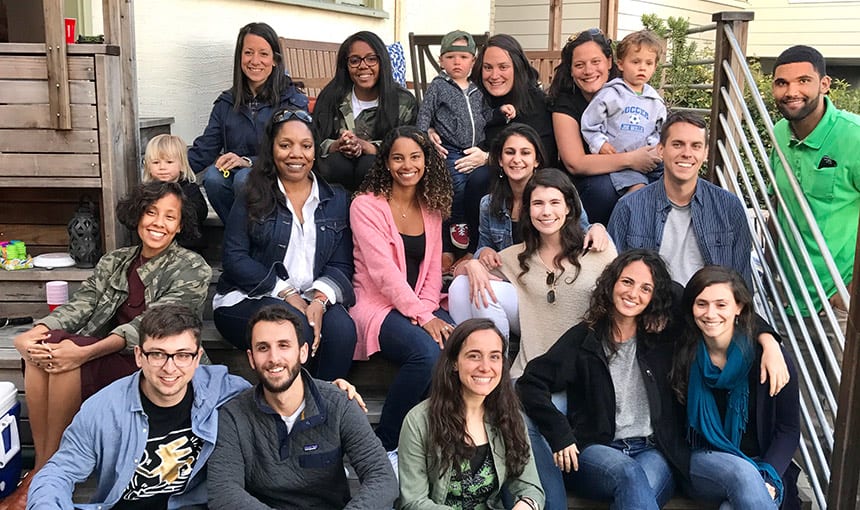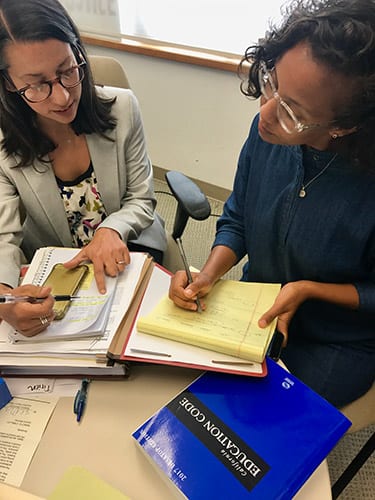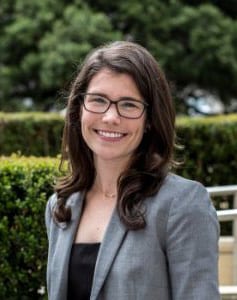
By Andrew Cohen
A unique collaboration between education advocates at Berkeley Law and local public defenders is providing hope—and stability—for vulnerable youth. Lawyers and students at the East Bay Community Law Center (EBCLC), working in its Education Advocacy Clinic and Youth Defender Clinic, are making a meaningful impact at the intersection of education and juvenile justice.
“In many ways, this partnership redefines youth advocacy,” said Kate Weisburd, who directs the Youth Defender Clinic. “Traditionally, education advocacy and juvenile defense exist in separate silos and public defenders aren’t able to address their clients’ complex educational needs. But through this collaboration, we work together to keep young people in school and out of the juvenile justice system.”
Youth arrested at school face criminal charges and expulsion. Many have learning disabilities that their schools fail to address. Berkeley Law students at the two clinics collaborate with Alameda County public defenders to identify their clients’ educational needs, consult with school administrators and teachers, and appear in court.

“A juvenile conviction results in additional barriers to education and employment,” said Rosa Bay, director of the Education Advocacy Clinic. “By pairing EBCLC’s education and reentry advocacy services with public defenders’ criminal defense work, we’re systematically addressing many of the reasons why young people become ensnared in—and stay in—the juvenile justice system.”
Over the past four years, EBCLC has assisted over 200 youth and families referred by public defenders. This work includes representing youth in special education, school discipline, and juvenile court proceedings; writing motions, demand letters, and legal complaints; and advising on problems with school enrollment, bullying, truancy, individualized education programs (IEPs), and restitution.
The center also recently launched a social work program. Supervised by attorney and licensed social worker Whitney Rubenstein ’14, social work students partner with law students to support system-involved youth and their families.
“More than three times as many incarcerated youth are eligible for special education than public school youth, yet most young people in the juvenile system have unmet learning needs,” Bay said. “They’re routinely kept on probation not because they’re committing new criminal offenses, but because of poor school performance. In many respects, our work helps change the narrative from one of guilt and fault to one of context and understanding.”
Filling a void
For Barbara Dickinson, who heads the Alameda County Public Defenders’ juvenile unit, EBCLC delivers a nuanced understanding of her clients’ learning needs.
“If kids get arrested in school or face expulsion or suspension proceedings, EBCLC provides pivotal information to teachers, principals, administrators, and judges,” she said. “They also make sure school districts are following students’ IEPs correctly so that, for example, a kid with an anxiety disorder isn’t subjected to large, chaotic settings. Unmet educational needs often lead to behavioral problems that result in kids needlessly landing in the juvenile system.”
During youth client intakes, Dickinson’s team now includes a release authorizing EBCLC to provide educational support.
“It saves my lawyers time and provides crucial help for our clients,” she said. “It also helps juvenile judges. They’re always receptive to EBCLC’s input because of its proven track record and because judges want a complete picture of the youth in question.”
Alameda County Superior Court Judge Jeffrey Brand ’69 confirmed that assertion. The former University of San Francisco School of Law dean sees benefits for both clients and law students.
“The more integration of services there is, the better judges can confront the fundamental issues driving behavior,” he said. “EBCLC’s involvement is so helpful and deeply appreciated by the court. This partnership is also a great vehicle for developing skilled, ethical lawyers. The more law students who understand how critical juvenile justice matters are—not only to minors, but to society in general—the better off we’ll be.”
Crisis management
One such student, Madeline Wiseman ’18, taught second grade in New Orleans as part of Teach for America. The school was later closed for violating special education laws.
“Many schools, including where I taught, funnel more resources and attention to kids who perform better academically than those who struggle,” Wiseman said. “Students who need the most help are often the ones who get ignored and kicked out of class for behavioral issues stemming from undiagnosed special education needs.”

One of her clients, “Dominic” (named changed to protect confidentiality), is 15. Although his mother sought to obtain special education services for years, her pleas were consistently ignored. After Dominic cycled in and out of juvenile hall for two years because of minor violations of his probation conditions and struggles in school, his public defender called EBCLC.
Wiseman and Bay conducted an extensive review of Dominic’s education history, interviewed him and his family, and pushed for a comprehensive reassessment by his school district. The district’s psychological evaluation determined that a profound intellectual disability caused Dominic’s problems in school—and that his comprehension was at a first-grade level.
Wiseman’s advocacy helped convince the district to move Dominic to a special education program where he now has more structure and support. He will receive special education services until age 22, and a juvenile court judge may consider dismissal of his case next month.
“If we weren’t able to describe Dominic’s severe learning disability, all the court would see is terrible attendance, a bad discipline record, and poor grades,” Wiseman said. “We’re reaching kids at a crisis point, but consider the costs involved over the years—judges, clerks, district attorneys, public defenders, people who work in juvenile hall. Imagine if that money was used to help Dominic at a much younger age. None of this would have happened.”
Wiseman sees more challenges ahead because “most teachers are underpaid, under-supported, and have too much on their plate. Also, if a student gets an IEP, the school district has to pay for that—which creates incentives to avoid it.”
Reversing the pipeline
Fanna Gamal ’16, who spent two years at EBCLC during law school, now works there full-time as an Equal Justice Works fellow supporting students being pushed out of schools. She sees the center’s partnership model as a promising template for removing youth from the juvenile system and returning them to school with better-tailored learning plans.
“This isn’t just about stopping the school-to-prison pipeline,” she said. “It’s about creating an alternative pipeline that places our youth on a productive learning path toward vocational school and college readiness.”
Such triumphs, however, are tempered with frustration. One of Gamal’s clients, a gender non-confirming student in Oakland, had a verbal argument with a school police officer after he made a homophobic comment. She was suspended for more than a month and criminally charged.
“That one incident set her on a path for prolonged involvement in the juvenile system,” Gamal said.
More than 75 percent of U.S. high schools have armed security staff, according to a 2014 National Center of Education Statistics report, and an American Civil Liberties Union study found that such police presence “has increased dramatically over the past two decades.” Last year, the Obama Administration advised states to limit the use of police in schools and ensure that trained educators, not law enforcement officers, handle student discipline.
“Criminalizing behavior at school is a growing problem,” Gamal said. “Students can be handcuffed and randomly searched. The potential for police interaction at school is very troubling, especially for young people of color.”
Weisburd describes such arrests as “a moment of crisis and complete destabilization.” EBCLC hopes to secure more funding to broaden its support during those pivotal moments.
In the meantime, lawyers in the Youth Defender and Education Advocacy clinics train and supervise roughly 25 students a year. Those students receive what Bay calls “a unique opportunity to better understand the problems related to the criminalization of youth of color, and the role they can play in ending it.”